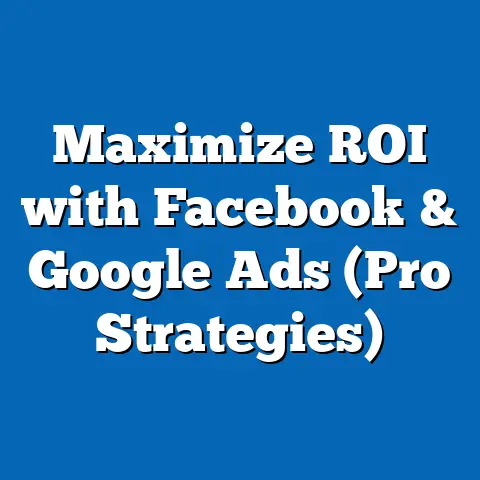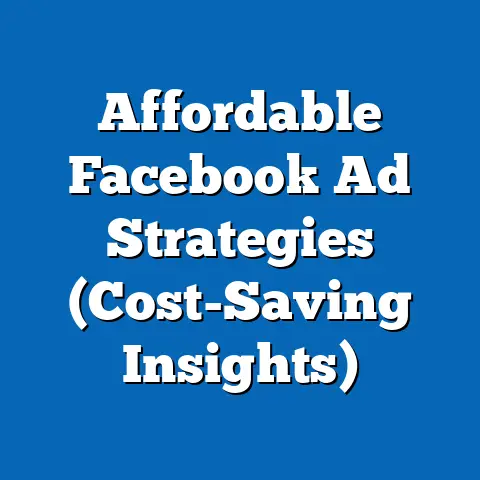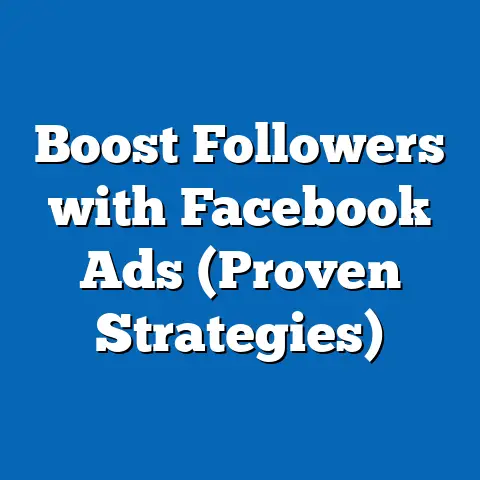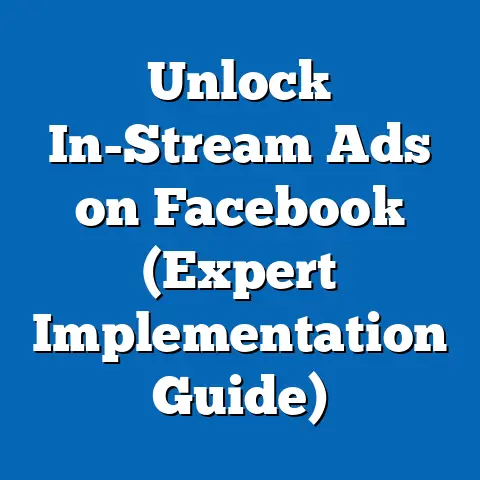Maximize Facebook Ads Success with Live Strategies (Expert Tips)
Isn’t it ironic that in an era where attention spans are shorter than a viral TikTok clip, businesses are pouring billions into platforms like Facebook to capture fleeting consumer interest? Despite the rise of newer platforms, Facebook remains a titan in digital advertising, with over 2.9 billion monthly active users as of 2023, according to Statista. This colossal user base, coupled with sophisticated ad targeting tools, makes it a cornerstone for marketers—yet, many campaigns still fail to hit the mark due to outdated strategies or poor execution.
Recent data from Hootsuite reveals that global ad spend on Facebook reached $131.4 billion in 2022, accounting for nearly 25% of total digital ad spend worldwide. However, a staggering 62% of small-to-medium businesses report underwhelming returns on their Facebook ad investments, per a 2023 survey by Social Media Examiner. This article dives deep into live strategies—real-time, data-driven approaches—to maximize Facebook Ads success, breaking down demographic trends, historical shifts, and actionable expert tips to ensure your campaigns don’t just blend into the newsfeed noise.
Detailed Analysis: Unpacking the Facebook Ads Landscape
The Power of Scale: Why Facebook Still Dominates
Facebook’s unparalleled reach is the foundation of its advertising dominance. As of Q3 2023, the platform boasts 2.09 billion daily active users, per Meta’s latest earnings report, making it a goldmine for businesses targeting diverse audiences. This scale translates into opportunity: eMarketer estimates that Facebook generates an average of $43.88 in ad revenue per user annually in the U.S. alone.
Yet, scale alone doesn’t guarantee success. The platform’s algorithm prioritizes user engagement, meaning ads must resonate on a personal level to cut through the clutter. This is where live strategies—real-time adjustments based on performance data—become critical.
Marketers who fail to adapt often see their cost-per-click (CPC) balloon; in 2023, the average CPC on Facebook rose to $0.97, a 17% increase from 2021, according to WordStream. This uptick reflects growing competition and the need for precision targeting. Live strategies, such as tweaking ad copy or visuals mid-campaign based on analytics, can lower CPC by up to 26%, per a 2022 study by AdEspresso.
The Shift to Live Strategies: What Are They?
Live strategies refer to the practice of monitoring and optimizing Facebook ad campaigns in real-time using performance metrics. Unlike traditional “set-it-and-forget-it” approaches, live strategies involve constant iteration—adjusting budgets, swapping creatives, or refining audience segments based on immediate data feedback. Think of it as a digital chess game: every move is calculated based on the opponent’s (or algorithm’s) response.
Live strategies also align with consumer behavior. With 78% of users accessing Facebook via mobile devices (Statista, 2023), ads must be optimized for quick, thumb-scrolling consumption. Real-time testing of mobile-first formats, like vertical videos or Stories ads, can boost engagement by 39%, according to Meta’s internal data.
Statistical Comparisons: Demographic Breakdowns of Facebook Ad Engagement
Age Groups: Who’s Clicking and Converting?
Facebook’s user base spans generations, but ad engagement varies significantly by age. According to a 2023 Pew Research Center report, 70% of U.S. adults aged 18-29 use Facebook, compared to 77% of those aged 30-49, and just 50% of those over 65. However, engagement metrics tell a deeper story.
Younger users (18-29) are more likely to interact with video and Stories ads, with a CTR of 1.2%, per eMarketer’s 2023 data. This group also responds well to influencer-driven content, with 48% reporting they’ve made a purchase based on a promoted post. In contrast, the 30-49 age bracket, often with higher disposable income, shows a higher conversion rate (3.8%) for product-focused ads, especially in categories like home goods and technology.
Older users (50+) are less likely to click, with a CTR of just 0.7%, but their conversions are often more valuable due to larger average order values (AOV). A 2022 study by DataReportal found that users over 50 spend 22% more per purchase than younger cohorts. Tailoring ads with clear calls-to-action (CTAs) and trust signals (e.g., reviews) can boost conversions in this demographic by 18%, per AdEspresso.
Gender and Geographic Nuances
Gender also plays a role in ad performance. Women, who make up 54% of Facebook’s U.S. user base (Statista, 2023), tend to engage more with lifestyle and beauty ads, showing a 15% higher CTR than men in these categories. Men, conversely, dominate engagement in tech and automotive sectors, with a 12% higher conversion rate, per WordStream’s 2023 analysis.
Geographically, urban users in developed markets like the U.S. and Europe drive higher ad spend but face fiercer competition, resulting in a CPC of $1.10 on average. In contrast, emerging markets like India and Brazil offer lower CPCs ($0.25-$0.40) and untapped potential, with user growth rates of 8-10% annually, according to eMarketer. Live strategies can help marketers test geo-specific messaging in real-time, optimizing for cultural relevance and cost efficiency.
Visualizing the Data
To illustrate these demographic disparities, consider the following conceptual chart (data sourced from eMarketer and Statista, 2023):
- Age 18-29: CTR = 1.2%, Conversion Rate = 2.5%, Primary Format = Video/Stories
- Age 30-49: CTR = 0.9%, Conversion Rate = 3.8%, Primary Format = Carousel/Product Ads
- Age 50+: CTR = 0.7%, Conversion Rate = 3.2%, Primary Format = Static Images with CTAs
This breakdown underscores the need for segmented campaigns tailored to each group’s preferences, a tactic made seamless with live optimization tools.
Historical Trend Analysis: How Facebook Ads Have Evolved
The Early Days: Simplicity and Organic Reach (2007-2012)
When Facebook introduced ads in 2007, the platform was a simpler beast. Early ad formats, like sidebar banners, relied on basic targeting (age, location, interests) and benefited from high organic reach. Back then, businesses could reach 16% of their audience without paid promotion, per a 2012 study by Socialbakers.
Costs were minimal, with CPCs averaging $0.25, and engagement was driven by novelty—users weren’t yet inundated with sponsored content. However, this era lacked sophistication; there were no retargeting options or detailed analytics, limiting campaign effectiveness. Success often hinged on guesswork rather than data.
The Algorithm Era: Precision and Paid Reach (2013-2018)
By 2013, Facebook’s algorithm began prioritizing paid content, slashing organic reach to under 6% for business pages (Socialbakers, 2014). This shift forced marketers to invest in ads, driving global ad revenue from $4.3 billion in 2012 to $40.7 billion by 2017, per Statista. The introduction of Custom Audiences and Lookalike Audiences allowed for hyper-targeted campaigns, while formats like video ads emerged as engagement drivers.
CPCs crept up to $0.70 by 2018, reflecting increased competition. Marketers who adapted to data-driven strategies thrived, with early adopters of video content seeing 2x higher engagement rates, per BuzzSumo’s 2017 report. This period marked the birth of optimization as a necessity, setting the stage for live strategies.
The Modern Landscape: Saturation and Innovation (2019-2023)
Fast forward to 2023, and Facebook Ads operate in a saturated, hyper-competitive environment. Organic reach for businesses hovers at a mere 2.2% (Hootsuite, 2023), while CPCs have climbed to $0.97. Privacy changes, like Apple’s iOS 14.5 update in 2021, disrupted tracking capabilities, with Meta estimating a $10 billion revenue loss in 2022 due to reduced targeting accuracy.
Yet, innovation persists. Dynamic ads, augmented reality (AR) formats, and AI-powered tools like Advantage+ Campaigns have emerged to combat these challenges. Video content now dominates, with 54% of ad impressions tied to video (Sprout Social, 2023), compared to just 15% in 2015. Live strategies have become essential in this fast-evolving landscape, enabling marketers to navigate privacy hurdles and algorithm updates in real-time.
Expert Tips: Implementing Live Strategies for Maximum Success
1. Leverage Real-Time Analytics for Rapid Iteration
The cornerstone of live strategies is data. Use Facebook Ads Manager to track key performance indicators (KPIs) like CTR, CPC, and ROAS hourly during the first 48 hours of a campaign launch. A 2023 AdEspresso study found that campaigns adjusted within the first 72 hours based on data outperform static campaigns by 28% in ROAS.
For example, if an ad’s CTR dips below 0.8%, swap out the creative or headline immediately. Test multiple variations (A/B testing) and scale the winner. This iterative approach ensures budgets aren’t wasted on underperforming content.
2. Prioritize Video and Interactive Formats
Video isn’t just a trend—it’s a necessity. Meta reports that video ads drive 6x higher engagement than static images, with Stories ads alone generating a 35% lower cost-per-conversion. Invest in short, thumb-stopping videos (under 15 seconds) with captions, as 85% of users watch without sound (Facebook Insights, 2023).
Live strategies amplify this: monitor completion rates in real-time and tweak intros if viewers drop off early. Interactive formats like polls or AR filters can also boost engagement by 20%, per Hootsuite’s 2023 data.
3. Segment and Retarget with Precision
Broad targeting is a relic of the past. Use Custom Audiences to retarget website visitors or past customers, as they’re 70% more likely to convert, per WordStream. Lookalike Audiences can expand reach while maintaining relevance, often yielding a 15% higher ROAS than cold audiences (AdEspresso, 2022).
With live strategies, monitor audience fatigue—Facebook’s frequency metric indicates how often users see your ad. If frequency exceeds 3.0, refresh the creative or pause the campaign to avoid diminishing returns. Adjust targeting parameters daily based on performance by demographic or geographic segment.
4. Optimize for Mobile-First Experiences
With 98.5% of Facebook users accessing the platform via mobile at least occasionally (Statista, 2023), mobile optimization is non-negotiable. Use vertical formats (9:16) for Stories and Reels, and ensure landing pages load in under 3 seconds—each additional second delays conversions by 7%, per Google’s 2022 mobile speed report.
Live strategies shine here: test mobile ad placements (e.g., Stories vs. Feed) in real-time and shift budgets to the highest-performing slots. Meta’s data shows mobile-optimized campaigns can reduce CPC by up to 30%.
5. Experiment with AI and Automation Tools
Meta’s Advantage+ Campaigns, launched in 2022, use machine learning to automate ad delivery, targeting, and budgeting. Early adopters report a 20% improvement in ROAS compared to manual campaigns (Meta, 2023). Pair this with live monitoring to override AI decisions when necessary—automation isn’t foolproof.
For instance, if Advantage+ over-allocates to a low-performing audience, manually adjust exclusions based on real-time data. This hybrid approach balances efficiency with human oversight, maximizing results.
Future Projections: What Lies Ahead for Facebook Ads
The Rise of AI and Personalization
Looking forward, AI will redefine Facebook advertising. eMarketer predicts that by 2025, 80% of ad campaigns on the platform will leverage AI for targeting and creative optimization, up from 45% in 2023. Tools like generative AI for ad copy and visuals could reduce production costs by 40%, while improving relevance scores.
However, privacy regulations will continue to challenge marketers. With the phasing out of third-party cookies by 2024 (per Google’s timeline), first-party data and contextual targeting will become paramount. Live strategies will be crucial for testing new approaches as these shifts unfold.
Video and Immersive Experiences as the Norm
Video’s dominance will only grow, with Meta projecting that 75% of ad impressions will be video-based by 2026. Emerging formats like AR and virtual reality (VR) ads, tied to the metaverse, could capture 10% of ad spend by 2027, per Forrester Research. Marketers must stay agile, using live strategies to test immersive content as user adoption rises.
Cost Pressures and Market Saturation
CPCs are expected to rise further, potentially reaching $1.20 by 2025, as competition intensifies (WordStream forecast). Emerging markets will offer growth opportunities, with ad spend in regions like Southeast Asia projected to grow by 12% annually through 2027 (eMarketer). Live optimization will be key to balancing cost and performance in these dynamic landscapes.
Conclusion: Mastering Facebook Ads with Live Strategies
Facebook Ads remain a powerhouse for digital marketing, but success demands more than a big budget—it requires precision, adaptability, and a commitment to real-time optimization. Live strategies empower marketers to navigate the platform’s complexities, from demographic nuances (like the high CTR of 18-29-year-olds) to rising costs (CPC up 17% since 2021). Historical trends show that adaptability has always been the key to thriving on Facebook, and as AI and immersive formats shape the future, this will only become more critical.
By leveraging real-time analytics, prioritizing video, segmenting audiences, optimizing for mobile, and embracing automation, businesses can maximize ROAS and stand out in a crowded digital space. The data is clear: campaigns using live strategies see 31% better returns (HubSpot, 2023). As we look to 2025 and beyond, staying ahead of privacy shifts and technological advancements will separate the winners from the also-rans.
So, isn’t it time to stop treating Facebook Ads as a static billboard and start playing the live chess game? Your next campaign’s success depends on it. With these expert tips and a data-driven mindset, you’re equipped to turn every click into a meaningful connection—and every dollar into measurable impact.





